
from:
http://charlesdickenspage.com
Narrative Facade
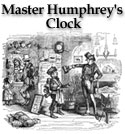
April 4, 1840
- Dec 4, 1841
Weekly journal written entirely by Dickens. The premise of the
journal was that Master Humphrey, along with friends, gathered
weekly to read stories which were stored in Master Humphrey's old
grandfather clock. Some original sketches brought back characters
from
Pickwick. After initial success, sales slumped and Dickens
introduced
The
Old Curiosity Shop, the serialization of which took over the
entire publication, sales skyrocketed, reaching 100,000 weekly. The
novel begins with Master Humphrey as narrator but as the story
continues he mysteriously disappears, reappearing briefly at the end
of the novel.
Barnaby Rudge was also published in Master Humphrey's
Clock.
References in the Text
Dickens fascination
with the theatre and his firm belief that the lower classes
must have their amusements lead to a love of
Punch and Judy shows. This familiar street entertainment
finds it way into The Old Curiosity Shop by way of
Codlin and Short, a traveling Punch show that Nell and her
grandfather meet on their travels.

In
describing the journey Nell and her grandfather take through
the English countryside Dickens creates a dream landscape in
which no place names are used. The village where Nell dies
is thought to be
Tong,
Shropshire, a place Dickens had visited. A wreath is
still placed every year outside St. Bartholomew's church at
the supposed grave of Little Nell.
1923
map showing
possible routes taken by Nell and her grandfather.
From 'A Dickens Atlas' by Albert A. Hopkins and
Newbury Frost Read.
Kit takes his mother
to Astley's theatre on the Surry side of the Thames on
Westminster Bridge Road. Phillip Astley, credited as a
pioneer of the modern circus, opened his theatre in 1774.
His show featured a ring and displays of horsemanship. |
|
19th-Century British Novel, SJSU (Fall 2006)
Dr. Katherine D. Harris
Information from Various Websites |
| |
|

Published in weekly parts
Apr 1840 - Feb 1841
Illustrated by
George Cattermole and
Phiz, with a single illustration each from
Samuel Williams and Daniel Maclise. This installment
novel, published in
Master Humphries Clock,
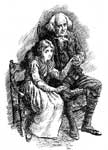 was
so popular that its weekly sales rose to a hundred
thousand. It tells the story of Nelly Trent and her
grandfather as they wander the English countryside,
north of London, trying to evade Daniel Quilp,
probably Dickens' most evil villain. Nell's
grandfather has borrowed money from Quilp to support
a gambling habit and has lost everything, including
the curiosity shop. As the conclusion of the story
neared Nell is exhausted from the travel and lack of
food. Dickens was inundated with letters begging him
to spare Nell's life. With the last installment
arriving by ship, crowds in New York shouted from
the pier "Is Little Nell Dead?" was
so popular that its weekly sales rose to a hundred
thousand. It tells the story of Nelly Trent and her
grandfather as they wander the English countryside,
north of London, trying to evade Daniel Quilp,
probably Dickens' most evil villain. Nell's
grandfather has borrowed money from Quilp to support
a gambling habit and has lost everything, including
the curiosity shop. As the conclusion of the story
neared Nell is exhausted from the travel and lack of
food. Dickens was inundated with letters begging him
to spare Nell's life. With the last installment
arriving by ship, crowds in New York shouted from
the pier "Is Little Nell Dead?"
The original for Nell is believed to be Dickens'
sister-in-law,
Mary Hogarth, who died suddenly at age 17 in
1837 and for whom Dickens still grieved.
|
Death-Bed of Little Nell
Dickens' instructions to George
Cattermole for the illustration The Death-Bed of
Little Nell:
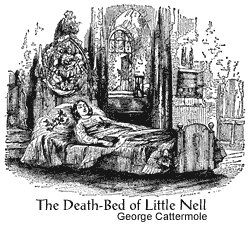 "The child lying dead in the little sleeping room,
which is behind the open screen. It is winter-time,
so there are no flowers; but upon her breast and
pillow, and about her bed, there may be strips of
holly and berries, and such free green things.
Window overgrown with ivy. The little boy who had
that talk with her about angels may be by the
bedside, if you like it so; but I think it will be
quieter and more peaceful if she is alone. I want it
to express the most beautiful repose and
tranquility, and to have something of a happy look,
if death can...I am breaking my heart over this
story, and cannot bear to finish it."
"The child lying dead in the little sleeping room,
which is behind the open screen. It is winter-time,
so there are no flowers; but upon her breast and
pillow, and about her bed, there may be strips of
holly and berries, and such free green things.
Window overgrown with ivy. The little boy who had
that talk with her about angels may be by the
bedside, if you like it so; but I think it will be
quieter and more peaceful if she is alone. I want it
to express the most beautiful repose and
tranquility, and to have something of a happy look,
if death can...I am breaking my heart over this
story, and cannot bear to finish it."
Leaving London
Dickens describes the scenery along
the road Nell and her grandfather take on their way
out of London.
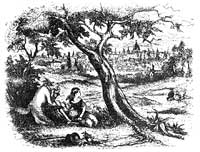 Damp
rotten houses, many to let, many yet building, many
half-built and mouldering away- lodgings, where it
would be hard to tell which needed pity most, those
who let or those who came to take-children, scantily
fed and clothed, spread over every street, and
sprawling in the dust- scolding mothers, stamping
their slipshod feet with noisy threats upon the
pavement-shabby fathers, hurrying with dispirited
looks to the occupation which brought them 'daily
bread' and little more-mangling-women, washer-women,
cobblers, tailors, chandlers, driving their trades
in parlours and kitchens and back room and garrets,
and sometimes all of them under the same
roof-brick-fields skirting gardens paled with staves
of old casks, or timber pillaged from houses burnt
down, and blackened and blistered by the
flames-mounds of dock-weed, nettles, coarse grass
and oyster-shells, heaped in rank confusion-small
dissenting chapels to teach, with no lack of
illustration, the miseries of Earth, and plenty of
new churches, erected with a little superfluous
wealth, to show the way to Heaven.
Damp
rotten houses, many to let, many yet building, many
half-built and mouldering away- lodgings, where it
would be hard to tell which needed pity most, those
who let or those who came to take-children, scantily
fed and clothed, spread over every street, and
sprawling in the dust- scolding mothers, stamping
their slipshod feet with noisy threats upon the
pavement-shabby fathers, hurrying with dispirited
looks to the occupation which brought them 'daily
bread' and little more-mangling-women, washer-women,
cobblers, tailors, chandlers, driving their trades
in parlours and kitchens and back room and garrets,
and sometimes all of them under the same
roof-brick-fields skirting gardens paled with staves
of old casks, or timber pillaged from houses burnt
down, and blackened and blistered by the
flames-mounds of dock-weed, nettles, coarse grass
and oyster-shells, heaped in rank confusion-small
dissenting chapels to teach, with no lack of
illustration, the miseries of Earth, and plenty of
new churches, erected with a little superfluous
wealth, to show the way to Heaven.
At length these streets becoming more
straggling yet, dwindled and dwindled away, until
there were only small garden patches bordering the
road, with many a summer house innocent of paint and
built of old timber or some fragments of a boat,
green as the tough cabbage-stalks that grew about
it, and grottoed at the seams with toad-stools and
tight-sticking snails. To these succeeded pert
cottages, two and two with plots of ground in front,
laid out in angular beds with stiff box borders and
narrow paths between, where footstep never strayed
to make the gravel rough.
Then came the public-house, freshly painted in green
and white, with tea-gardens and a bowling green,
spurning its old neighbour with the horse-trough
where the waggons stopped; then, fields; and then,
some houses, one by one, of goodly size with lawns,
some even with a lodge where dwelt a porter and his
wife. Then came a turnpike; then fields again with
trees and hay-stacks; then, a hill, and on the top
of that, the traveller might stop, and-looking back
at old Saint Paul's looming through the smoke, its
cross peeping above the cloud (if the day were
clear), and glittering in the sun; and casting his
eyes upon the Babel out of which it grew until he
traced it down to the furthest outposts of the
invading army of bricks and mortar whose station lay
for the present nearly at his feet-might feel at
last that he was clear of London.
|
|
|
Serializing the Novel
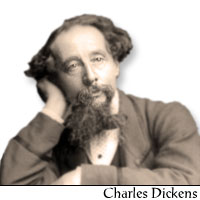 In
his book The English Novel Walter Allen describes
Dickens as the "great novelist who was also the great
entertainer, the greatest entertainer, probably, in the
history of fiction." Dickens' genius as entertainer manifest
itself in his first novel
The
Pickwick Papers. Pickwick, a loose collection of the
zany adventures of
Samuel Pickwick and his friends, was a departure from
the traditional novel and was instantly a smash success.
This success happened at a time when huge technological
strides were being made in manufacturing and steam travel,
helping Dickens' fame to spread worldwide.
In
his book The English Novel Walter Allen describes
Dickens as the "great novelist who was also the great
entertainer, the greatest entertainer, probably, in the
history of fiction." Dickens' genius as entertainer manifest
itself in his first novel
The
Pickwick Papers. Pickwick, a loose collection of the
zany adventures of
Samuel Pickwick and his friends, was a departure from
the traditional novel and was instantly a smash success.
This success happened at a time when huge technological
strides were being made in manufacturing and steam travel,
helping Dickens' fame to spread worldwide.
Dickens' ability to capture the imagination of his audience,
many of them new to fiction due to a rise in literacy during
the industrial revolution, was due largely to his amazing
power of observation, incredible wit, unforgettable
characters, and a command of the English language probably
second only to Shakespeare. His fiction provided a voice for
the causes and frustrations of the poor and working classes
helping to assure popularity across class boundaries.
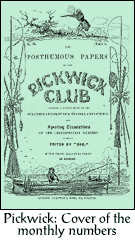 Another factor contributing to
Dickens meteoric rise in popularity was the way in
which he and his publishers,
Chapman and
Hall, chose to publish his books. All of Dickens
major novels were published serially, in monthly (or
weekly) installments. A full length novel was out of
the price range of most of his readers ( a novel
cost 31 shillings in 1836, average worker earned 6
to 20 shillings per week) but a monthly installment,
32 pages with 2 illustrations and
advertisements, could be sold for a shilling.
Another factor contributing to
Dickens meteoric rise in popularity was the way in
which he and his publishers,
Chapman and
Hall, chose to publish his books. All of Dickens
major novels were published serially, in monthly (or
weekly) installments. A full length novel was out of
the price range of most of his readers ( a novel
cost 31 shillings in 1836, average worker earned 6
to 20 shillings per week) but a monthly installment,
32 pages with 2 illustrations and
advertisements, could be sold for a shilling.
Dickens wrote each installment with this type of
publication in mind, many of the installments ended
with a hook that kept the readers glued to the edge
of their Victorian seats wondering what would happen
next, thus ensuring the sales of the next
installment. This type of arrangement worked
perfectly for the workaholic Dickens, whose
unbounded energy and inexhaustible supply of
imagination enabled him to keep to the tight writing
schedule required by serial publication for nearly
35 years, during which he missed only two deadlines:
when his
sister-in-law died during the writing of
The Pickwick Papers and
Oliver Twist, and his own death in 1870
while writing
The Mystery of Edwin Drood. |
Later Editions
Upon completion of serialization the works were issued as
complete novels in one to three volumes with original, and
in some instances, additional illustrations. Starting in
1847 the older novels were reissued in what was called the
Cheap Edition, these were published in weekly and monthly
parts, and then as complete novels. Eventually all of
Dickens' novels were reissued in the Cheap Edition. The
concept of the Cheap Edition was similar to today's practice
of reissuing hardback novels as more affordable paperbacks.
Other editions published during Dickens lifetime include the
Library Edition: a high quality set published without
illustrations in 1858/59. This set was reissued between 1861
and 1874 with illustrations and was called the Illustrated
Library Edition. In 1867 the Charles Dickens Edition was
released. This edition featured new prefaces, written by
Dickens, who also made minor corrections to the text.
Chapman and Hall produced the Peoples Edition in 1865-1867,
these were inexpensive monthly installments of the novels
aimed at travelers in the very popular bookstalls popping up
in railway stations all over Britain.
Dickens' works were also published in
America, sometimes simultaneously with the British edition
and often with little or no compensation to the author or
his publishers due to the lack of an international copyright
law. Dickens campaigned unsuccessfully for international
copyright during his
first
American visit in 1842. An English-American copyright
law would not be enacted until 1891.
Dickens novels continue to be published today in popular
series like the Oxford Illustrated Edition, which include
the original illustrations, and the Penguin English
Library's paperback edition.
| The British
Museum's online exhibition:
Aspects of the Victorian Book explains how
everything from mechanized printing presses,
expanded railway lines, lower postage prices,
and increased literacy all contributed to the
publishing bonanza of 19th-century England.
|
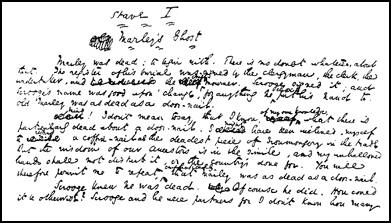
The Pierpont Morgan Library, New
York. MA 97.
All of Dickens' novels were submitted to the
printer in pen-and-ink (and blobs!). The
typesetter would have to carefully decipher the
sometimes illegible handwriting, written in the
passion of the creative moment. The first
typewriters came on the market in 1874, four
years after Dickens' death. This is a portion of
the original manuscript for the opening stave of
A Christmas Carol. |
|
By Charles Dickens,
With Numerous Illustrations by Cattermole
and Browne. Philadelphia: Lea & Blanchard.
MASTER
HUMPHREY'S CLOCK
By Charles Dickens.
(Boz.) With Ninty-one Illustrations by
George Cattermole and Hablot Browne. Philadelphia: Lea &
Blanchard.
WHAT WE here give [the above titles] is the duplicate title,
on two separate title-pages, of an octavo volume of three
hundred and sixty-two pages. Why this method of nomenclature
should have been adopted is more than we can understand-
although it arises, perhaps, from a certain confusion and
hesitation observable in the whole structure of the book
itself. Publishers have an idea, however, (and no doubt they
are the best judges in such matters) that a complete work
obtains a readier sale than one "to be continued;" and we
see plainly that it is with the design of intimating the
entireness of the volume now before us, that "The Old
Curiosity Shop and other Tales," has been made not only the
primary and main title, but the name of the whole
publication as indicated by the back. This may be quite fair
in trade, but is morally wrong not the less. The volume is
only one of a series- only part of a whole; and the title
has no right to insinuate otherwise. So obvious is this
intention to misguide, that it has led to the absurdity of
putting the inclusive, or general, title of the series, as a
secondary instead of a primary one. Anybody may see that if
the wish had been fairly to represent the plan and extent of
the volume, something like this would have been given on a
single page-
MASTER
HUMPHREY'S CLOCK
By Charles
Dickens. Part I. Containing The Old Curiosity Shop,
and other tales, with numerous illustrations, &c. &c.
This would have
been better for all parties, a good deal more honest, and a
vast deal more easily understood. In fact, there is
sufficient uncertainty of purpose in the book itself,
without resort to mystification in the matter of title. We
do not think it altogether impossible that the rumors in
respect to the sanity of Mr. Dickens which were so prevalent
during the publication of the first numbers of the work, had
some slight- some very slight foundation in truth. By this,
we mean merely to say that the mind of the author, at the
time, might possibly have been struggling with some of those
manifold and multiform aberrations by which the nobler order
of genius is so frequently beset- but which are still so
very far removed from disease.
* * * |
|
The Old Curiosity Shop
from "Best of Times: The
Theatre of Charles Dickens"
http://www.nypl.org/research/lpa/dickens/curiosity.html
|
|
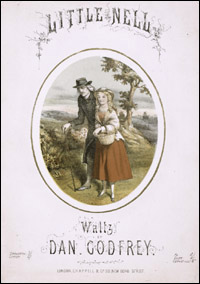 |
|
The character of Little Nell in The Old Curiosity
Shop was so beloved that Victorians trod the
dance floor in her name. |
The Old Curiosity Shop
has had a peculiar history. Well-received when first
published in 1840-1841, it has since been reviled by those
who find it overly sentimental. Little Nell has been
variously described by critics as �vulgar,� �heroic,�
�noble� and �a monster with two heads.� The American actress
Lotta Crabtree had great success playing the dual child
roles of Little Nell and the Marchioness from 1866 to 1887
when Miss Crabtree was well past 40. She is represented in
this exhibition as the Marchioness fitting Dickens�s
description of �a small slip-shod girl in a dirty coarse
apron�.� As a play, The Old Curiosity Shop did not
successfully survive the 20th century.
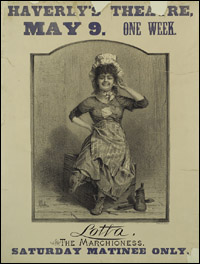 |
|
In numerous productions spanning 20 years, Lotta
Crabtree played the dual role of Little Nell and the
Marchioness in The Old Curiosity Shop. |
|
|
Significant and
Best-Selling Victorian Novels, 1837-1861
|
1839
W. H. Ainsworth |
Jack Sheppard |
serialised |
| Captain Frederick
Maryat |
The Phantom Ship
|
serialised |
|
|



 In
his book The English Novel Walter Allen describes
Dickens as the "great novelist who was also the great
entertainer, the greatest entertainer, probably, in the
history of fiction." Dickens' genius as entertainer manifest
itself in his first novel
The
Pickwick Papers. Pickwick, a loose collection of the
zany adventures of
Samuel Pickwick and his friends, was a departure from
the traditional novel and was instantly a smash success.
This success happened at a time when huge technological
strides were being made in manufacturing and steam travel,
helping Dickens' fame to spread worldwide.
In
his book The English Novel Walter Allen describes
Dickens as the "great novelist who was also the great
entertainer, the greatest entertainer, probably, in the
history of fiction." Dickens' genius as entertainer manifest
itself in his first novel
The
Pickwick Papers. Pickwick, a loose collection of the
zany adventures of
Samuel Pickwick and his friends, was a departure from
the traditional novel and was instantly a smash success.
This success happened at a time when huge technological
strides were being made in manufacturing and steam travel,
helping Dickens' fame to spread worldwide. 

 was
so popular that its weekly sales rose to a hundred
thousand. It tells the story of Nelly Trent and her
grandfather as they wander the English countryside,
north of London, trying to evade Daniel Quilp,
probably Dickens' most evil villain. Nell's
grandfather has borrowed money from Quilp to support
a gambling habit and has lost everything, including
the curiosity shop. As the conclusion of the story
neared Nell is exhausted from the travel and lack of
food. Dickens was inundated with letters begging him
to spare Nell's life. With the last installment
arriving by ship, crowds in New York shouted from
the pier "Is Little Nell Dead?"
was
so popular that its weekly sales rose to a hundred
thousand. It tells the story of Nelly Trent and her
grandfather as they wander the English countryside,
north of London, trying to evade Daniel Quilp,
probably Dickens' most evil villain. Nell's
grandfather has borrowed money from Quilp to support
a gambling habit and has lost everything, including
the curiosity shop. As the conclusion of the story
neared Nell is exhausted from the travel and lack of
food. Dickens was inundated with letters begging him
to spare Nell's life. With the last installment
arriving by ship, crowds in New York shouted from
the pier "Is Little Nell Dead?"  "The child lying dead in the little sleeping room,
which is behind the open screen. It is winter-time,
so there are no flowers; but upon her breast and
pillow, and about her bed, there may be strips of
holly and berries, and such free green things.
Window overgrown with ivy. The little boy who had
that talk with her about angels may be by the
bedside, if you like it so; but I think it will be
quieter and more peaceful if she is alone. I want it
to express the most beautiful repose and
tranquility, and to have something of a happy look,
if death can...I am breaking my heart over this
story, and cannot bear to finish it."
"The child lying dead in the little sleeping room,
which is behind the open screen. It is winter-time,
so there are no flowers; but upon her breast and
pillow, and about her bed, there may be strips of
holly and berries, and such free green things.
Window overgrown with ivy. The little boy who had
that talk with her about angels may be by the
bedside, if you like it so; but I think it will be
quieter and more peaceful if she is alone. I want it
to express the most beautiful repose and
tranquility, and to have something of a happy look,
if death can...I am breaking my heart over this
story, and cannot bear to finish it." 
 Another factor contributing to
Dickens meteoric rise in popularity was the way in
which he and his publishers,
Another factor contributing to
Dickens meteoric rise in popularity was the way in
which he and his publishers,


